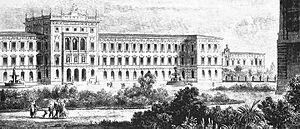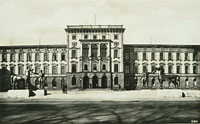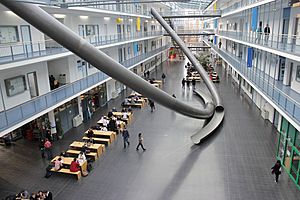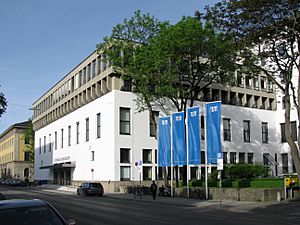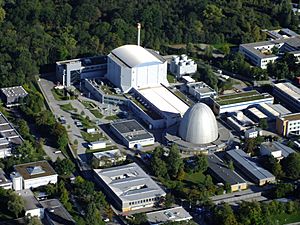Technical University of Munich facts for kids
|
Technische Universität München
|
|
 |
|
| Motto | The Entrepreneurial University |
|---|---|
| Type | Public |
| Established | 1868 |
| Founder | Ludwig II of Bavaria |
|
Academic affiliation
|
|
| Budget | €1,892.9 million (2023)
|
| President | Thomas Hofmann (list of presidents) |
|
Academic staff
|
698 professors 8,037 (other academic staff) |
|
Administrative staff
|
4,262 (without university hospital) |
| Students | 52,931 (WS 2024–25) |
| Address |
Arcisstraße 21
,
,
,
80333
,
48°08′56″N 11°34′01″E / 48.149°N 11.567°E |
| Campus | Urban |
| Colors | Blue, White |
 |
|
The Technical University of Munich (TUM) is a big public university in Munich, Germany. It's famous for teaching and researching subjects like engineering, technology, medicine, and different sciences.
King Ludwig II of Bavaria started the university in 1868. Today, TUM has campuses in places like Garching, Freising, Heilbronn, Straubing, and Singapore. The Garching campus is the biggest one.
TUM is one of the largest universities in Germany. It has over 52,900 students and a large yearly budget. It is known as a "University of Excellence" in Germany. Many of its researchers and former students have won important awards, including 18 Nobel Prizes.
Contents
History of TUM
How it Started in the 1800s
In 1868, King Ludwig II of Bavaria opened the Polytechnische Schule München. It was a new school for technical studies. It started with about 350 students and 45 teachers. The school was divided into six main areas. These included mathematics, natural sciences, civil engineering, architecture, mechanical engineering, chemistry, and agriculture.
In 1877, the school changed its name to Technische Hochschule München (TH München). By 1901, it could award doctorate degrees. It became Germany's largest technical university. In 1970, it got its current name, Technische Universität München.
The 1900s and Beyond
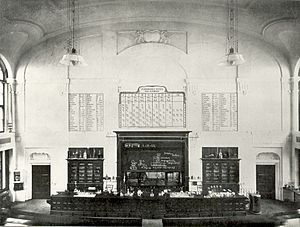
In 1906, Anna Boyksen became the first female student to study electrical engineering. This happened after women were allowed to study at technical universities in Germany. Later, in 1927, Martha Schneider-Bürger became the first German woman to graduate as a civil engineer from the university.
During World War II, about 80 percent of the university's buildings in Munich were damaged. Despite this, teaching started again in April 1946.
In 1956, TUM began building a research reactor in Garching. This was the start of the Garching campus. Over the years, many science departments moved there. In 1967, a TUM School of Medicine was created. By 1968, the university had six main areas of study and over 8,000 students.
In 1970, the university officially became the Technische Universität München. In 1992, computer science became its own department.
TUM in the 2000s

In 2002, TUM opened a branch in Singapore called TUM Asia. This was the first time a German university had a branch outside Germany. TUM Asia offers master's and bachelor's degrees.
Over the years, TUM has added new schools and departments. These include the Department of Sport and Health Sciences and the School of Management. By 2023, TUM had seven schools and 29 research departments.
TUM has been recognized as a "University of Excellence" since 2006. This means it receives special funding for its top-level research and teaching.
TUM Campuses
TUM has several campuses in different locations.
Munich Campuses
The main campus is in downtown Munich. Here you'll find departments like Architecture, Civil, Geo and Environmental Engineering, and Electrical and Computer Engineering. The Schools of Management, Governance, and Education are also here.
The TUM School of Medicine is located at the Rechts der Isar Hospital in Munich. The TUM Department of Sport and Health Sciences is in the Olympiapark, which was built for the 1972 Summer Olympics.
Garching Campus
The Garching campus is about 10 kilometers north of Munich. It's the largest TUM campus. Many science and engineering departments have moved here. These include Physics, Chemistry, Mechanical Engineering, Informatics, and Mathematics.
Garching is also home to many research centers. These include the Max Planck Institutes and the Forschungsreaktor München II (FRM II), which is a research reactor. The European Southern Observatory (ESO) and one of Europe's fastest supercomputers are also there.
A famous landmark on the Garching campus is the Oskar von Miller Tower. It's a 62-meter-tall tower used for weather measurements. The Garching campus has its own fire department.
Weihenstephan Campus
The third TUM campus is in Weihenstephan, Freising, about 35 kilometers north of Munich. This campus is home to the School of Life Sciences.
Other Locations
TUM also has facilities in Ottobrunn, Straubing, Heilbronn, and Singapore.
What You Can Study and Research

TUM is a technical university. This means it focuses on engineering, technology, medicine, and sciences. It doesn't offer studies in subjects like law or many social sciences.
As of 2025, TUM has seven main schools:
- TUM School of Computation, Information and Technology (CIT)
- TUM School of Engineering and Design (ED)
- TUM School of Natural Sciences (NAT)
- TUM School of Life Sciences (LS)
- TUM School of Medicine and Health (MED)
- TUM School of Management (MGT)
- TUM School of Social Sciences and Technology (SOT)
There is also the TUM Campus Straubing.
Research at TUM
TUM is one of Europe's top universities for research. It gets a lot of funding for its research projects.
TUM has many research centers. Some combine research with teaching, like the TUM Institute for Advanced Study (TUM-IAS). Others work with companies on new inventions. These include the research reactor FRM II and the Catalysis Research Center (CRC).
Working with Others
TUM has over 160 partnerships with universities around the world. These include:
- Europe: ETH Zurich, EPFL, Technical University of Denmark
- United States: MIT, Stanford University, Cornell University
- Asia: National University of Singapore, Tsinghua University, University of Tokyo
- Australia: Australian National University, University of Melbourne
Students can also study abroad through programs like Erasmus+ and TUMexchange.
University Rankings
TUM is highly ranked among universities worldwide.
- It is ranked 22nd globally by QS World University Rankings (2026).
- It is ranked 26th globally by Times Higher Education World University Rankings (2025).
- It is ranked 47th globally by Academic Ranking of World Universities (2024).
TUM is often ranked as the number one university in Germany in these global lists. Its graduates are also highly sought after by employers. In 2025, TUM graduates were ranked 13th globally for employability.
TUM is also highly ranked in specific subjects:
- QS World Rankings (2024):
* Engineering and Technology: 19th globally (1st in Germany) * Natural Sciences: 23rd globally (1st in Germany) * Computer Science: 31st globally (1st in Germany)
- Times Higher Education (2024):
* Engineering: 22nd globally (1st in Germany) * Physical Sciences: 22nd globally (1st in Germany) * Computer Science: 15th globally (1st in Germany)
Student Life
As of winter 2024/25, TUM has over 52,900 students. About 36% are female, and 45% are international students.
Student Groups and Projects
Students at TUM run many cool groups and projects:
- TEDxTUM: Students organize talks with famous speakers. Past speakers include Ban Ki-moon and Bill Gates.
- IKOM: A big career fair to help students find jobs.
- Workgroup for Rocketry and Space Flight (WARR): This group won all SpaceX Hyperloop pod competitions from 2017 to 2019.
- TUM Boring: This team won a tunnel-boring competition in Las Vegas in 2021.
- Indy Autonomous Challenge: In 2023, a TUM team won second place in a race for self-driving cars.
Student Government
The Student Council is the main group that represents all students at the university. They elect the General Student Committee (AStA), which works to help students with their studies and daily life. Each school also has its own student council.
Fun Events
The Student Council organizes many fun events each year:
- TUNIX and GARNIX: These are week-long outdoor festivals held every summer. TUNIX is near the Munich campus, and GARNIX is at the Garching campus.
- GLÜHNIX: A Christmas market held in December.
- MaiTUM: A Bavarian spring festival held in May.
Sports and Music
The Zentrale Hochschulsportanlage (ZHS) is Germany's largest university sports center. It offers hundreds of different sports programs for students.
TUM also has many music groups, including a Chamber Orchestra, a Jazz Band, a Choir, and a full Symphony Orchestra.
Famous People from TUM
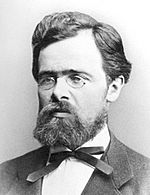
Many famous people have studied or taught at TUM.
Nobel Prize Winners
17 Nobel Prize winners have been connected to TUM:
- 1927 – Heinrich Otto Wieland, Chemistry
- 1929 – Thomas Mann, Literature
- 1930 – Hans Fischer, Chemistry
- 1961 – Rudolf L. Mößbauer, Physics
- 1964 – Konrad Emil Bloch, Physiology or Medicine
- 1973 – Ernst Otto Fischer, Chemistry
- 1985 – Klaus von Klitzing, Physics
- 1986 – Ernst Ruska, Physics
- 1988 – Johann Deisenhofer and Robert Huber, Chemistry
- 1989 – Wolfgang Paul, Physics
- 1991 – Erwin Neher, Physiology or Medicine
- 2001 – Wolfgang Ketterle, Physics
- 2007 – Gerhard Ertl, Chemistry
- 2016 – Bernard L. Feringa, Chemistry
- 2017 – Joachim Frank, Chemistry
- 2022 – Anton Zeilinger, Physics
Other Famous Scientists and Inventors
- Rudolf Diesel, inventor of the Diesel engine
- Claude Dornier, airplane designer
- Emil Erlenmeyer, chemist, known for the Erlenmeyer flask
- Carl von Linde, inventor of the refrigeration cycle
- Willy Messerschmitt, famous aircraft designer
- Oskar von Miller, engineer, who founded the Deutsches Museum
Astronauts
- Samantha Cristoforetti, an astronaut for the European Space Agency (ESA)
See also
 In Spanish: Universidad Técnica de Múnich para niños
In Spanish: Universidad Técnica de Múnich para niños
- Education in Germany
- List of universities in Germany


